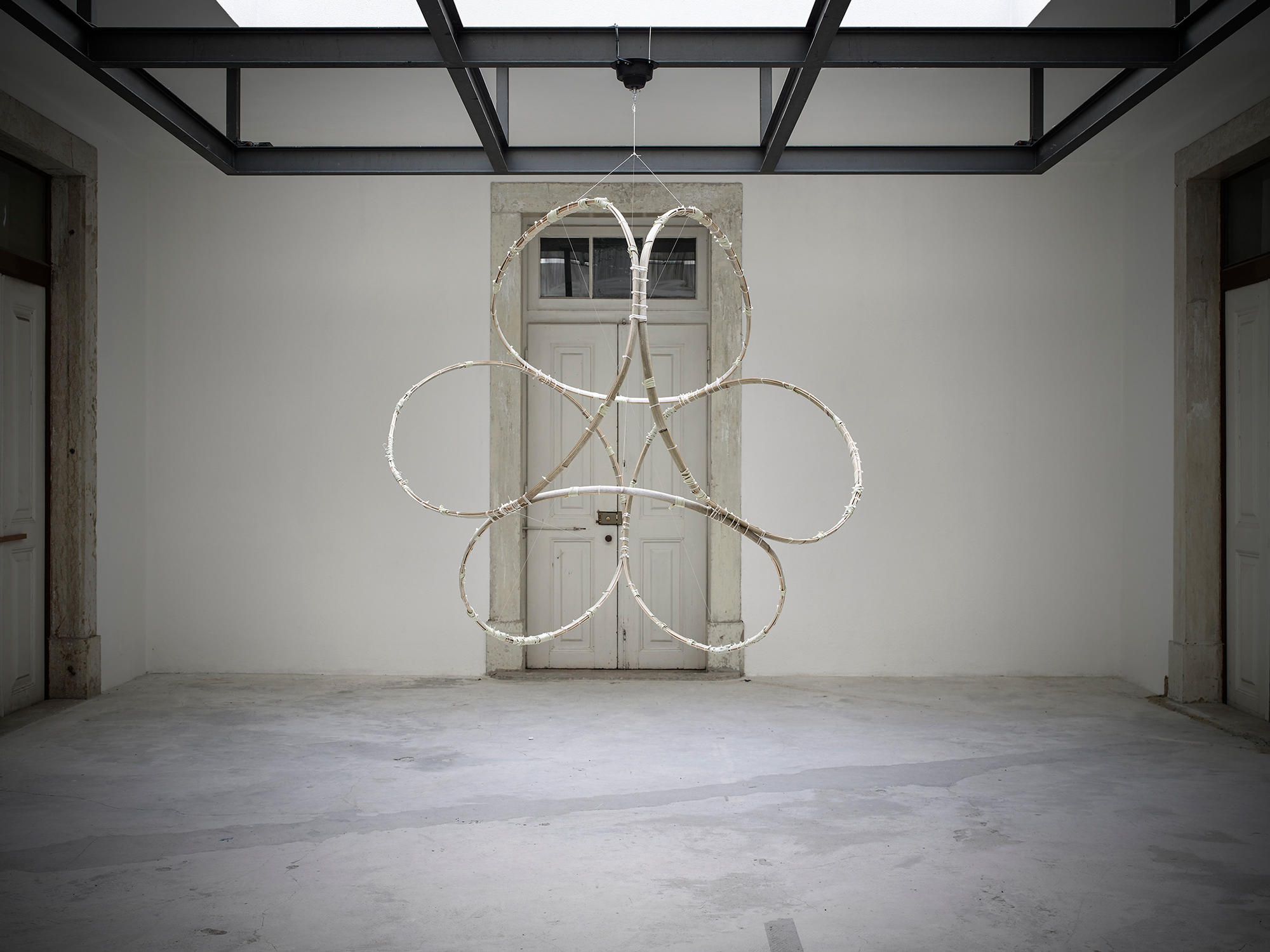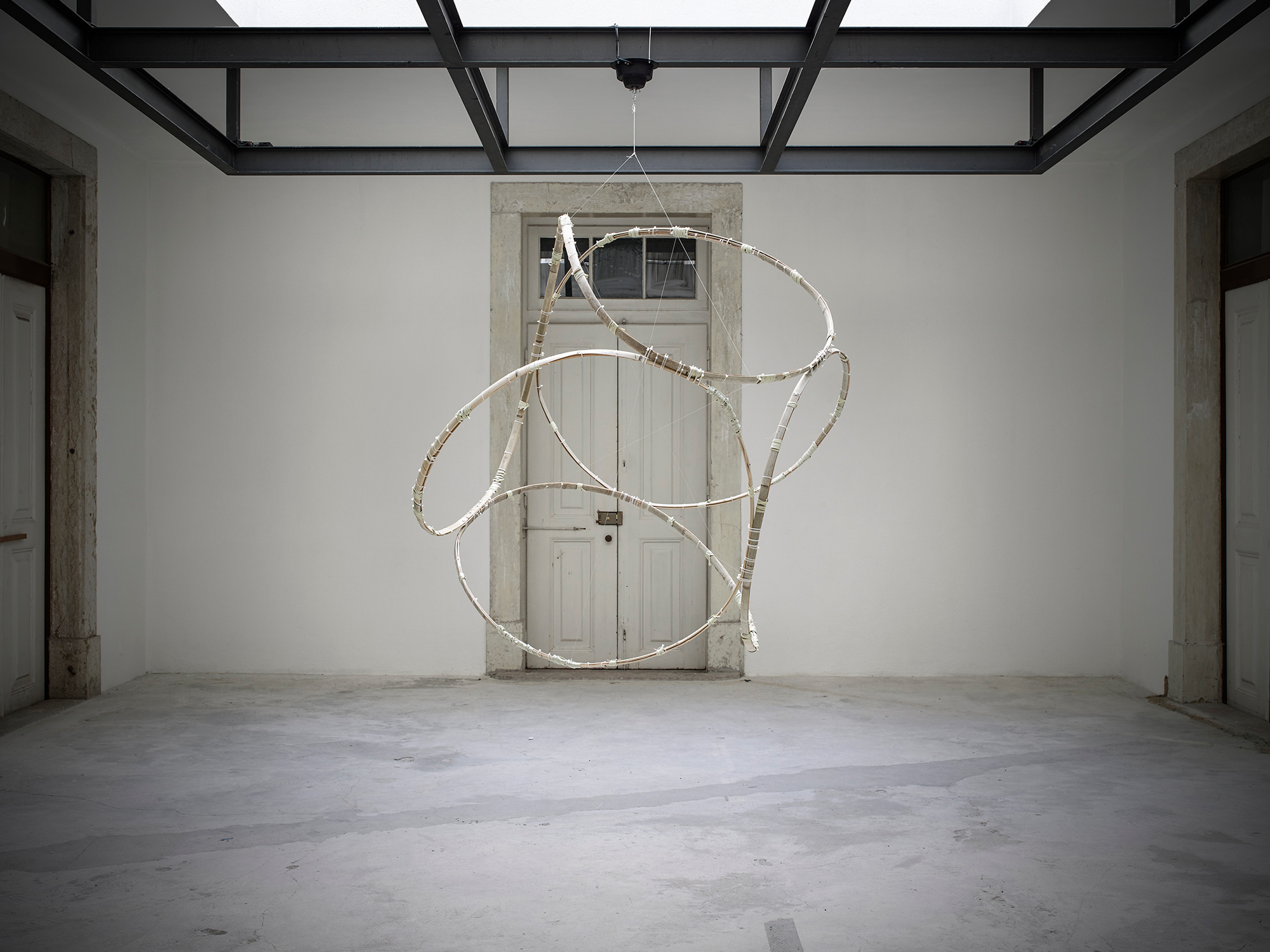Model for the Impossible Black Tulip
Harry room of
National Museum of Natural History and Science
National Museum of Natural History and Science
On the right side of the entrance-hall we reach a square room with skylight. In the center one can see a cubic shape in rotation hung by one of its vertices.
A mnemonic exercise: consider the cubic object a space of memory; the faces are to be called mappa mundi and its continents; the irregularity of their circular shapes: black tulip; the infinite line without beginning nor end and its inability to reverse: impossibility.
We are facing the Model for the impossible black tulip, a prototype that features a converging, connected and continuous topological space solved according to the principles of the Möbius strip. This revolving sculpture made up of an infinite spiral line defines its form through the presence of six circular sides in an isometric perspective.
Out of curiosity, and because of its rarity, importance and exoticism, the mappa mundi developed by Ricci in the Chinese language was called the black tulip of cartography.
Through architectural expression and sculpture, Memory Palace celebrates Ricci, the intercultural encounter, sharing of knowledge, friendship, but it also points to the discussion on the nature of memory at a philosophical level. The subjective experience of time, duration and consciousness, the psychic dimension of memory, the relations between thought and language, the function of signs and words in human experience.
A mnemonic exercise: consider the cubic object a space of memory; the faces are to be called mappa mundi and its continents; the irregularity of their circular shapes: black tulip; the infinite line without beginning nor end and its inability to reverse: impossibility.
We are facing the Model for the impossible black tulip, a prototype that features a converging, connected and continuous topological space solved according to the principles of the Möbius strip. This revolving sculpture made up of an infinite spiral line defines its form through the presence of six circular sides in an isometric perspective.
Out of curiosity, and because of its rarity, importance and exoticism, the mappa mundi developed by Ricci in the Chinese language was called the black tulip of cartography.
Through architectural expression and sculpture, Memory Palace celebrates Ricci, the intercultural encounter, sharing of knowledge, friendship, but it also points to the discussion on the nature of memory at a philosophical level. The subjective experience of time, duration and consciousness, the psychic dimension of memory, the relations between thought and language, the function of signs and words in human experience.
Exhibition
Memory Palace
Project
João Ó, Rita Machado
Year
22 October 2015 – 15 February 2016
Curator
Natxo Checa
Organization
Museu Nacional de História Natural e da Ciência
Production
Impromptu Projects,
Zé dos Bois Gallery
Publication
Catalogue (Link)
Sponsor
Macau Foundation, Cultural Affairs Bureau of Government of Macau S.A.R., Macau Government Tourism Office, Macao Economic and Trade Office, Orient Foundation
Memory Palace
Project
João Ó, Rita Machado
Year
22 October 2015 – 15 February 2016
Curator
Natxo Checa
Organization
Museu Nacional de História Natural e da Ciência
Production
Impromptu Projects,
Zé dos Bois Gallery
Publication
Catalogue (Link)
Sponsor
Macau Foundation, Cultural Affairs Bureau of Government of Macau S.A.R., Macau Government Tourism Office, Macao Economic and Trade Office, Orient Foundation
Photography
Cláudio Balas
Technical Support
Bambu Parque,
Sinapse – Architectural Light Design,
OpenLab FCUL,
Fabricado de Seng Kei
Acknowledgements
Gabriela Perdigão Cavaco, José Pedro Sousa Dias, Gabriela César, Maria Helena de Senna Fernandes, Ana Paula Cleto, João Amorim, Kent Ieong Chi Kin, Sofia Marçal, Rodolfo Faustino, Paula Rainha, Francisco Santos, David Pera, Ivo Costa, Swallow Xu, Rui Cascais Parada, Rita Machado, Samuel Leong Sek Min, Noah Ng Fong Chao, Jorge Prudêncio, Marta Lourenço, Maria Judite Alves, Vanda Santos, Liliana Póvoas, Ireneia Melo, Palmira Carvalho, Raquel Barata, Catarina Teixeira, Gonçalo Magalhães, Yves Crouzet, Raquel Campos, Pedro Alexandre Dias, Ricardo Ferreira, Marco António, Chio Seng Wai, Leung Wo, Leung Sio Fong, Daniela Ribeiro, Marta Furtado, Marco Balesteros
Cláudio Balas
Technical Support
Bambu Parque,
Sinapse – Architectural Light Design,
OpenLab FCUL,
Fabricado de Seng Kei
Acknowledgements
Gabriela Perdigão Cavaco, José Pedro Sousa Dias, Gabriela César, Maria Helena de Senna Fernandes, Ana Paula Cleto, João Amorim, Kent Ieong Chi Kin, Sofia Marçal, Rodolfo Faustino, Paula Rainha, Francisco Santos, David Pera, Ivo Costa, Swallow Xu, Rui Cascais Parada, Rita Machado, Samuel Leong Sek Min, Noah Ng Fong Chao, Jorge Prudêncio, Marta Lourenço, Maria Judite Alves, Vanda Santos, Liliana Póvoas, Ireneia Melo, Palmira Carvalho, Raquel Barata, Catarina Teixeira, Gonçalo Magalhães, Yves Crouzet, Raquel Campos, Pedro Alexandre Dias, Ricardo Ferreira, Marco António, Chio Seng Wai, Leung Wo, Leung Sio Fong, Daniela Ribeiro, Marta Furtado, Marco Balesteros
1 of 4
read more





